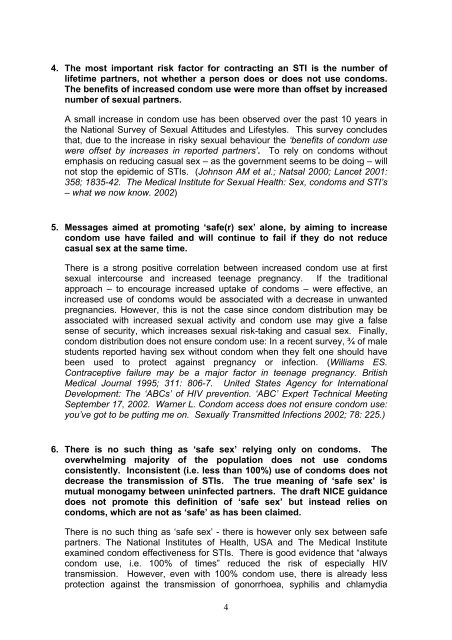STIs & Teenage pregnancy
STIs & Teenage pregnancy - The Maranatha Community
STIs & Teenage pregnancy - The Maranatha Community
Create successful ePaper yourself
Turn your PDF publications into a flip-book with our unique Google optimized e-Paper software.
4. The most important risk factor for contracting an STI is the number oflifetime partners, not whether a person does or does not use condoms.The benefits of increased condom use were more than offset by increasednumber of sexual partners.A small increase in condom use has been observed over the past 10 years inthe National Survey of Sexual Attitudes and Lifestyles. This survey concludesthat, due to the increase in risky sexual behaviour the ‘benefits of condom usewere offset by increases in reported partners’. To rely on condoms withoutemphasis on reducing casual sex – as the government seems to be doing – willnot stop the epidemic of <strong>STIs</strong>. (Johnson AM et al.; Natsal 2000; Lancet 2001:358; 1835-42. The Medical Institute for Sexual Health: Sex, condoms and STI’s– what we now know. 2002)5. Messages aimed at promoting ‘safe(r) sex’ alone, by aiming to increasecondom use have failed and will continue to fail if they do not reducecasual sex at the same time.There is a strong positive correlation between increased condom use at firstsexual intercourse and increased teenage <strong>pregnancy</strong>. If the traditionalapproach – to encourage increased uptake of condoms – were effective, anincreased use of condoms would be associated with a decrease in unwantedpregnancies. However, this is not the case since condom distribution may beassociated with increased sexual activity and condom use may give a falsesense of security, which increases sexual risk-taking and casual sex. Finally,condom distribution does not ensure condom use: In a recent survey, ¾ of malestudents reported having sex without condom when they felt one should havebeen used to protect against <strong>pregnancy</strong> or infection. (Williams ES.Contraceptive failure may be a major factor in teenage <strong>pregnancy</strong>. BritishMedical Journal 1995; 311: 806-7. United States Agency for InternationalDevelopment: The ‘ABCs’ of HIV prevention. ‘ABC’ Expert Technical MeetingSeptember 17, 2002. Warner L. Condom access does not ensure condom use:you’ve got to be putting me on. Sexually Transmitted Infections 2002; 78: 225.)6. There is no such thing as ‘safe sex’ relying only on condoms. Theoverwhelming majority of the population does not use condomsconsistently. Inconsistent (i.e. less than 100%) use of condoms does notdecrease the transmission of <strong>STIs</strong>. The true meaning of ‘safe sex’ ismutual monogamy between uninfected partners. The draft NICE guidancedoes not promote this definition of ‘safe sex’ but instead relies oncondoms, which are not as ‘safe’ as has been claimed.There is no such thing as ‘safe sex’ - there is however only sex between safepartners. The National Institutes of Health, USA and The Medical Instituteexamined condom effectiveness for <strong>STIs</strong>. There is good evidence that “alwayscondom use, i.e. 100% of times” reduced the risk of especially HIVtransmission. However, even with 100% condom use, there is already lessprotection against the transmission of gonorrhoea, syphilis and chlamydia4








